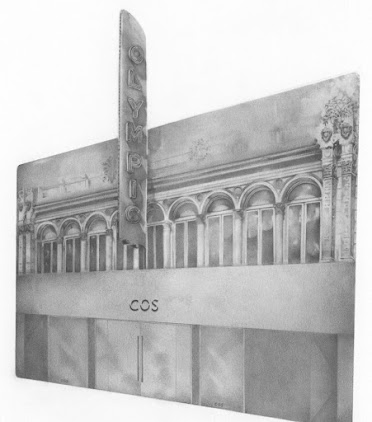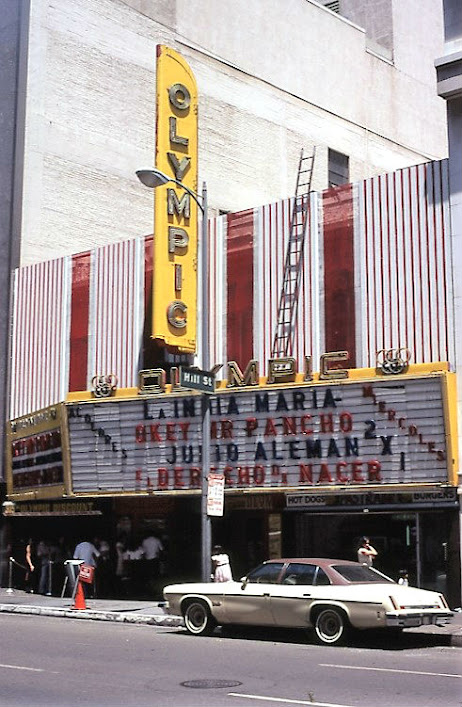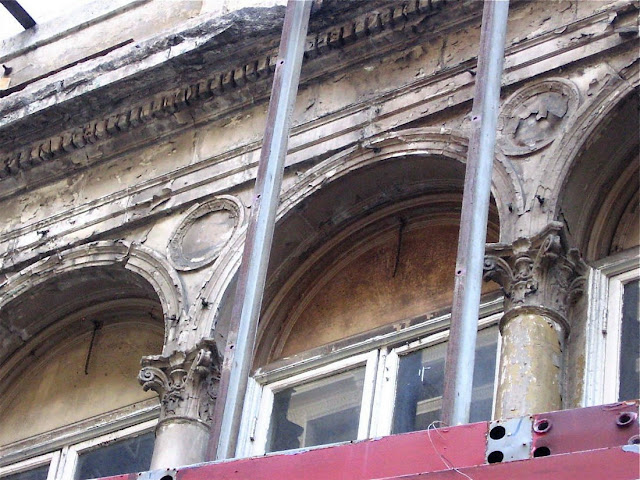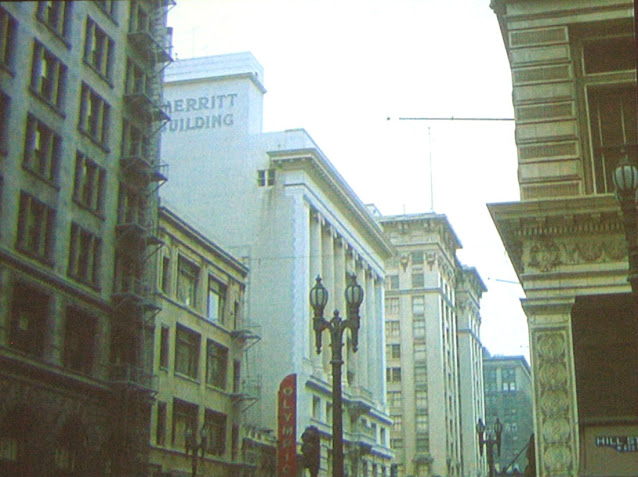313 W. 8th St. Los Angeles, CA 90014 | map |
Also see: Olympic Theatre - interior views
The news: It's vacant. The COS store that was in the building closed in June 2022
Opened: April 2, 1927 as Bard's 8th St. Theatre with the Universal comedy "Oh, Baby" starring Madge Kennedy and Creighton Hale. In the early 30s there was (very briefly) also an entrance at 757 S. Broadway. In recent years the building had been used for retail. Photo: Bill Counter - 2010
Architect: The building was constructed in 1917 as a restaurant, the Maison Marcell. Frank Meline was both architect and contractor for owner Joseph Marcel Annechini. The project was announced in the September 23, 1917 issue of the L.A. Times. A progress report and an updated rendering appeared in the November 11 issue. The L.A. Record issue of April 25, 1922 noted the sale of the restaurant to Eddie Brandstratter, who planned a renovation. Thanks to Noirish Los Angeles contributor Gaylord Wilshire for posting the articles on Noirish post #57257. Additional material is on Odinthor's Noirish post #57258.
Lewis A. Smith did the theatre conversion. He designed many theatres in the Los Angeles area including others for Lou Bard and a number of projects for West Coast Theatres. Bard usually liked Egyptian interiors but this one had a Chinese flavor. Charles O. Matcham did a remodel in 1942.
"Conceived in an Oriental atmosphere totally different from anything in the city." It's an April 2, 1927 opening day ad located by Ken McIntyre.
An article about the opening that appeared in the Friday April 1, 1927 L.A. Times. Lou Bard operated a number of other theatres including two nearby Hill Street theatres, the Town Theatre and the College Theatre. Bard's was the circuit that also built the Vista Theatre on Sunset Dr. in the Los Feliz area. Bard's Egyptian Theatre in Pasadena (later the Colorado) is still running as the Academy 6. Bard also had the Glen Theatre in Glendale, Bard's West Adams and the Garfield in Alhambra.
Prior to the Bard's 8th Street conversion, the building on the 50' x 130' lot was called Crillon Cafe. The construction cost for the theatre conversion was advertised as $200,000. Total square footage, per Brigham Yen, is 9,835 split into three levels: basement 3,289 SF, ground floor 5,520 SF, mezzanine 1,026 SF.
Surviving until 2016 from the restaurant era was a set of skylights on the mezzanine. Some were still visible in the theatre lounge areas along the front of the building. Others remained but were obscured by the addition of a projection booth on the mezzanine. The back of the building has bricked-in windows from the building's days before it was a theatre.
A 1927 ad for films from the Tunney-Dempsey fight. Thanks to Ken McIntyre for locating it for a comment to a post on the Photos of Los Angeles Facebook page.
The Broadway entrance: In 1930, Bard's added a second entrance through the north storefront of the Merritt Building at 8th & Broadway. This entrance provided a larger lobby than the original one on 8th. This new lobby didn't intersect with the original -- patrons came into the auditorium via a doorway in the house right wall at a crossaisle about a third of the way down from the back of the auditorium.
The November 30, 1930 issue of the Los Angeles Times discussed the project:
A 1934 ad for the Olympic. Thanks to Ken McIntyre for finding it for a post on the Photos of Los Angeles private Facebook group.
Starting in the 1940s the theatre had a suggestion book in the lobby for patron suggestions and was known as the Olympic Request Theatre. Looking down from Broadway one of the vertical signs would say "Olympic" and the second one "Request." Roger Christiansen comments:
"In the early 1960s it was still the 'Olympic Request Theater' that changed double features weekly with a mix of sub run and old classics. There was a printed calendar. There were 'ballots' to vote for future bills. They showed a lot of 'women’s films,' and shoppers from the nearby May Co department store could sit in the safety of a 'ladies only' section in the rear."
A
1984 Metropolitan ad listing the Olympic and a few of their other Spanish language houses.
Thanks to Ross Melnick for sharing this. He's a professor of film and
media studies at UC Santa Barbara and is the founder of the Cinema Treasures website. His latest book is "Hollywood's Embassies: How Movie Theatres Projected American Power Around the World."
Closing: It closed as a film house in 1997.
It was used for storage and retail after closing as a theatre. Most of the original "Oriental" decor was gone except for elaborate sidewall column capitols, a ceiling medallion from a 40s remodel, ornament around the proscenium and organ grilles, and the glass ceiling on the mezzanine. The late 90s renovation involved leveling the floor, removing the booth, redoing the stairs and gutting the storefront spaces on either side of the theatre entrance. See the interior views page for lots of photos.
New Owners: Curbed L.A. ran a May 2010 story by Dakota Smith about the building being for sale: "Downtown's Olympic Theatre Can be All Yours." At the time the asking price was $2.3 million. A listing on Loopnet indicated
that the property had sold in September 2013. For a few years before the sale the
theatre was a showroom for light fixtures and furniture with the store
having an eternal "closing soon" sale. They finally cleared out at the
end of 2013.
A June 6, 2016 story on Racked L.A. included this rendering from LDA Design Group of Burbank. Demolition began in late 2016. The upper part of the facade got rehabbed with a new storefront installed on the ground level.
The vertical sign was restored and re-lit. It got its present configuration and current centered location sometime between 1947 and early 1950. As late as 1947 there were still two verticals on the building, neither looking like the present one. Our first look at the new sign is in a 1950 Getty Images film clip. We also see it in "The War of The Worlds," a 1953 release.
None of the remaining vintage interior elements survived the remodel. COS opened in late August 2017. Brigham Yen had a story and photos about the occasion on his blog DTLA Rising.
More exterior views:
1927 - A view looking west on 8th St. from Broadway. The photo from the Automobile Club of Southern California is in the USC Digital Library collection.
1927 - A detail of the theatre's entrance from the USC photo above.
1927 - Another look at the corner from the Automobile Club of Southern California that's in the USC Digital Library collection. As usual, the poor theatre is on the margin.
1931 - A detail from the previous photo by Joseph Carter. Note part of the vertical for Loew's State, down at the other end of the block at 7th St.
1931 - A great postcard showing the marquee of the Bard's Broadway entrance on the right. Thanks to Gerald DeLuca for sharing this card from his collection on Photobucket. That north bay in the Merritt Building was soon retail space again after it was abandoned as a theatre entrance. Later
the entire ground floor of the building was remodeled to become a branch of Home
Savings. Bard's 8th St. was renamed the Olympic Theatre in 1932.
This card also gives us a view of the Majestic Theatre vertical farther down the street on the right just before the greenish Eastern Columbia building. In the left foreground the marquee of the President / Globe Theatre is advertising the King Vidor film "Street Scene," a September release with Sylvia Sidney, William Collier Jr. and Estelle Taylor.
c.1938 - A look east on 8th St. from Hill with a glimpse of the Olympic (15 cents admission) on the left. Down at 8th & Broadway we see the Tower Theatre. That's the May Co. on the right. It's a Herman Schultheis photo in the Los Angeles Public Library collection.
c.1939 - A Dick Whittington Studio photo looking toward Broadway. It's in the USC Digital Library collection.
c.1939 - A detail from the Dick Whittington Studio photo above.
1940s - Well it's not much, but here's a view down 8th St. with the Olympic's sign visible on the right hand side of the street. The RKO Hillstreet is on the left a block away. It's a Los Angeles Public Library photo.
1950 - The Olympic running Hitchcock's "The Paradine Case," a 1947 release with Gregory Peck and Ann Todd plus a Sonja Henie second feature. By this time the theatre had a new vertical sign at the center of the facade, replacing the two earlier signs.
It's a shot from a short clip from Ultra Film appearing on the Getty Images website that Ken McIntyre located for a post on the private Facebook group Photos of Los Angeles. At the beginning of the clip we get a closer look at the Tower, then called the Music Hall. They had "Love Happy," an October 1949 release with the Marx Brothers, Ilona Massey and Vera-Ellen. The co-feature was "Tyrant of the Sea" with Rhys Williams and Don Randell.
1957 - An Examiner photo in the USC Digital Library collection gives us a sliver of the theatre at the far left.
1971 - 99 cents got you in to see "Deliciosamente Amoral," a 1969 romantic comedy from Argentina starring Libertad Leblanc and Guillermo Bredeston. It was released in Mexico as "Sandra." The co-feature, "Carne," was a 1968 release from Argentina with Isabel Sarli and Victor Bo. Many thanks to Sean Ault for sharing this photo from his collection.
1980 - A photo from the now-vanished American Classic Images website of the theatre in its Spanish language days. The vertical had been red when it was installed sometime between 1947 and 1950. When this new marquee went up they painted it to match.
1981 - The signage gone yellow. With that ladder in place maybe they were still working on it. Thanks to American Classic Images for the photo.
1983 - The theatre at night in a photo from the American Classic Images collection.
1983 - We get a closer view from the east thanks to American Classic Images.
1988 - A Gary Graver photo. Over several decades he took many photos of theatres in Los Angeles and Portland, OR. Many can be seen in two compilations on YouTube: "Second Run - Part 1" and "Second Run - Part 2." Thanks to Sean Graver for use of the photo.
1992 - "Supercop" with Jackie Chan and "Terminator 2" with Arnold. The next year we'd get a shot of Arnold in front of the theatre in "Last Action Hero." Thanks to the legendary Ken McIntyre for the photo on the Facebook page Photos of Los Angeles. The theatre would close in 1997.
2004 - The tarps are up as interior renovations are underway. Work at this time included replacing the sloped auditorium floor with a flat one, clearing out lobby area construction, removing the projection booth from the mezzanine, and adding new stair access up to that level. Thanks to Sean Ault for sharing his photo.
2007 - The building in its "Downtown Design Center" days. Photo: Bill Counter
2007 - A peek at the Olympic's original facade hiding behind the "modern" metal cladding. Photo: Bill Counter
January 2010 - An early morning view looking east toward the Tower Theatre a half block away on Broadway. Photo: Bill Counter - 2010
February 2010 - Removal of the metal cladding had begun. Photo: Bill Counter
February 2010 - A detail of the upper part of the facade. Photo: Bill Counter
March 2010 - The exterior all spruced up and ready to remove the scaffolding. Thanks to Hillsman Wright for his photo on the on the LAHTF Facebook page.
May 2010 - The cleaned up facade. The metal cladding formerly obscuring the facade was removed. The exterior was cleaned and painted in preparation for selling the building. It took a while to find a buyer. Photo: Bill Counter
May 2010 - Another view of the newly cleaned up facade. Photo: Bill Counter
May 2010 - A detail of the facade ornamentation. The little gold sprigs of foliage were a new touch. Photo: Bill Counter
2010 - The rear of the building (gray). Note the bricked-in windows from the former use as a restaurant. Most of the back of the building is hidden behind behind the pinkish building on the left. Photo: Bill Counter
2010 - The Merritt Building at 8th and Broadway, once the site of a Broadway entrance for the Olympic. The theatre is just behind with its vertical peeking up above the traffic light. Photo: Bill Counter
2010 - No sign of the theatre entrance that used this space beginning in 1930. Well, it's been 80+ years. The Merritt Building's Broadway storefronts are 757, 759 and 761 S. Broadway. The theatre entrance was in this north storefront at 757. Photo: Bill Counter
A peek into the storefront that had once been the Olympic's Broadway lobby. Photo: Bill Counter
2013 - East toward the Merritt Building and Broadway. Photo: Bill Counter
2013 - West toward Hill St. Thanks to Ken McIntyre for his photo, a post on the private Facebook group Photos of Los Angeles.
November 2013 - A look down on the Olympic -- with the eternal "Everything Must Go" sale. Photo: Hunter Kerhart
February 2017 - Thanks to Dion Noravian on the DTLA Development Facebook page for his photo of the building shortly after removal of the marquee. In a comment to Dion's post, Mars Bravo of the Los Angeles Sign Company noted that his firm got the contract for work on the vertical sign.
March 2017 - The vertical sign is scaffolded for restoration work. Photo: Hunter Kerhart
March 2017 - The first glimpse of the new colors for the vertical -- blue with bright yellow letters. It had all been painted black -- including the tubing. Photo: Hunter Kerhart
March 2017 - A look at the facade's condition after the removal of the marquee. Photo: Hunter Kerhart
March 2017 - A bit of long-concealed ornament revealed behind the vertical's support. Photo: Hunter Kerhart
April 2017 - A look west after removal of the scaffolding for the sign. Thanks to Marty Culbert for his photo. See his post on the DTLA Development Facebook page for three more views.
April 2017 - The newly restored vertical sign. Thanks to James Lin for his photo.
April 2017 - Sign work completed but lots to do on the rest of the facade. Photo: Hunter Kerhart
April 2017 - A view from across the street. Photo: Hunter Kerhart
April 2017 - A view from the west. Photo: Hunter Kerhart
August 2017 - The Olympic vertical lit again. Thanks to Bao Le for his photo on the DTLA Development Facebook page.
August 2017 - The vertical from below. Thanks to Paul Wright for his photo, one of three views of the building on a post on the Facebook page DTLA Development.
August 2017 - The facade unveiled after the COS renovations. Thanks to Nicholas Libert for his photo on the DTLA Development Facebook page.
August 2017 - The COS store almost ready for shoppers. Photo: Hunter Kerhart
More on the Hulett C. Merritt Building: The building at 8th & Broadway is a design of the San Francisco based firm Reid Brothers. It was begun in 1914 and opened in 1915. Originally the first floor was retail.
The Merritt Building in October 1916. This was before the building that was to become the theatre was constructed just to the west. Here an earlier building on the site is visible. It's a photo by G. Haven Bishop from the Huntington Digital Library collection.
A c.1965 look toward the Merritt Building when Home Savings was the ground floor tenant. Thanks to Sean Ault for finding the photo.
After restoration the building was being revealed in a slow striptease, one floor at a time. Photo: Bill Counter - April 2020
The Olympic Theatre in the Movies:
We get this view of the Olympic when we go "uptown" in "The Falcon's Alibi" (RKO, 1946). Tom Conway
plays an amateur detective solving a jewel robbery and multiple murders.
Jane Greer does two numbers as a nightclub
songstress. Also featured are Paula Corday, Elisha Cook Jr., Vince
Barnett, Emory Parnell,
Esther Howard, Jean Brooks and Jason Robards. Ray McCarey directed.
The cinematography was by Frank Redman. See the Historic L.A. Theatres in Movies post for another Olympic shot plus a murky view of the Warner at 7th and Hill.
We get a glimpse of the Olympic in the Rita Hayworth film "Down To Earth" (Columbia, 1947). But it's only via a process shot -- we see tantalizing downtown L.A. footage out the rear window of a taxi Rita is riding in. It's much more interesting to look directly at the footage they shot. It's on Internet Archive as "Downtown Los Angeles streets."
It's an 11 minute tour shot on May 8, 1946 giving us glimpses of what seems like a vanished
world -- including of lots of theatres and upscale storefronts. The RKO
Hillstreet is in the distance with the Olympic on the right. There's also a black and white version on Internet Archive as "Downtown Los Angeles..." with some of the same views but also many other
theatres including the Globe, Arcade, Cameo, Roxie and Broadway not
seen in the color footage.
Another look at the Olympic marquee in the "Down To Earth" footage shot in 1946 -- a much flashier confection than the one on the building in the 70s and beyond. On the tour we get night vistas of 7th and 8th streets as well as (at the end) a look at all the theatres on the east side of Broadway. See the Historic L.A. Theatres In Movies post for some closer shots of the RKO Hillstreet.
As the Martians get close to the city we get this shot east on 8th St. in "The War of the Worlds" (Paramount, 1953). That's the Hillstreet vertical on the right and the Olympic down in the block between Hill St. and Broadway.
A closer look at the theatre's new vertical in "War of the Worlds." Previously there were two (one on each edge of the facade) and quite different in style. See the Historic L.A. Theatres In Movies post for another shot looking south on Hill St. with a view of the Mason Theatre stagehouse.
Charlton Heston pulling up in front of the Olympic in Boris Sagal's "The Omega Man" (Warner Bros., 1971).
Heston leaving the Olympic after watching a reel of "Woodstock" in "The Omega Man." We also get a booth view -- he had to thread up the film and strike up the Magnarc (with the door open!) as well as an auditorium shot (done elsewhere). In addition, there are several views down 8th that include the Tower Theatre. See the Historic L.A. Theatres In Movies post for those shots.
We get a view of the Olympic in this shot of a vampire nightclub on the corner in "Blade" (New Line Cinema, 1998). It features Wesley
Snipes, Kris Kristofferson, N'Bushe Wright, Stephen Dorff,
Donal Logue, Udo Kier and Tracy Lords. Stephen Norrington directed. The
cinematography was by Theo van
de Sande. See the Historic L.A. Theatres in Movies post for a dozen more shots of the downtown theatres seen in the film.
Edward Norton and Helena Bonham Carter have a scene in front of the Olympic in David Fincher's "Fight Club" (20th Century Fox, 1999). On the marquee is "Seven Years in Tibet," a Brad Pitt film from 1997. Pitt is, of course, also in "Fight Club." See the Historic L.A. Theatres In Movies post on for another shot on 8th St. showing the Tower Theatre as well as shots of a scene filmed in the booth at the Los Angeles.
Near the beginning of Mark Steven Johnson's "Daredevil" (20th Century Fox, 2003) we see the Olympic dressed up as a New York City boxing arena. Note that that the brick walls on either side of the main entrance are just set dressing.
The USC Digital Library has a 1939 Dick Whittington photo of the Merritt as we look north on Broadway. The Los Angeles Public Library has a view from 1957 when Millard Sheets did a redesign to make it a branch of Home Savings. Also there's a much earlier undated view of the Broadway facade in the LAPL collection. The Pacific Coast Architecture Database has a page on the Merritt.
The Olympic Theatre pages: back to top - history + exterior views | interior views |
| Downtown: theatre district overview | Hill St. and farther west | Broadway theatres | Spring St. theatres | Main St. and farther east | downtown theatres by address | downtown theatres alphabetical list |
| Westside | Hollywood | Westwood and Brentwood | Along the Coast | [more] Los Angeles movie palaces | the main alphabetical list | theatre history resources | film and theatre tech resources | theatres in movies | LA Theatres on facebook | contact info | welcome and site navigation guide |



































































































Night view of theatre exterior in Falcon's Alibi 1946 with Tom Conway
ReplyDeleteThanks! It's now on the page. Much appreciated.
Delete